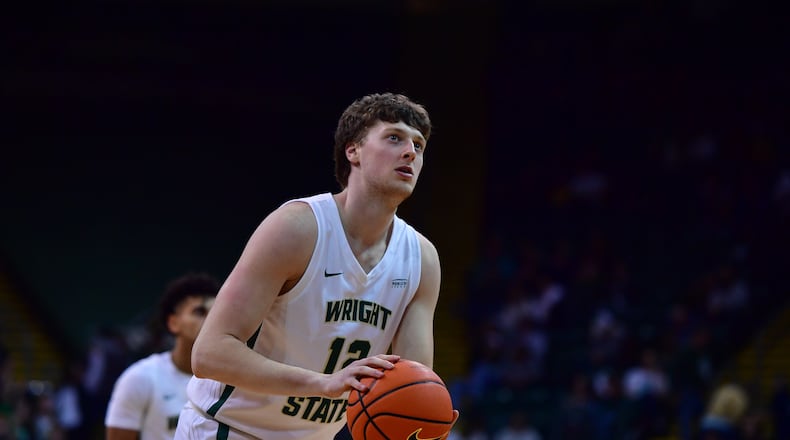Braun’s destination hasn’t been made public, but his departure was a surprise because it seemed as if he’d found the proper level for his skill set and was in an offense that emphasized post play.
He reached career highs in scoring at 12.0 per game and rebounds at 6.1 this year, and he led the team with 36 blocks.
“We’re sad, and it hurts our team. But we’re always of the belief that if somebody doesn’t want to be here, then they shouldn’t be here,” coach Scott Nagy said.
“We’ve never panicked over losing anybody, and we’re not with this deal. We wish him the best.”
The 6-foot-9 Springboro product, a Fenwick High School grad, set a Horizon League record by shooting 68.9% from the field this season, and his 62.5% career mark is just shy of the school record held by Gary Monroe.
He’s one of three players leaving who still have eligibility left.
Freshman Dayjaun Anderson, who redshirted this season, also is transferring. The 6-2 guard averaged 18 points and 7.3 rebounds as a senior at Ponitz High School and was the Dayton Public Schools player of the year.
Senior wing Andrew Welage also decided not to come back for his fifth season of eligibility (his class is the last one that has a fifth-year option because of the pandemic).
His playing time dwindled at the end of the season, but he was the team’s top 3-point shooter at 45.2% and averaged 5.1 points.
He went 7 of 10 on 3′s in a 25-point night at Indiana.
“Andrew decided to be done. He’s going to graduate,” Nagy said.
“I’m not exactly sure what he’ll do, but we kind of felt he was leaning that way anyway. We had a good talk with him. We’re just sad we couldn’t do a Senior Night for him and recognize him.”
Anderson fell behind classmate Kaden Brown, the back-up point guard who was the only true freshman to get playing time.
Keaton Norris, who took the unusual step of redshirting as a junior last season, also is back. He started 13 games at point guard in 2022-23 and averaged 3.0 points.
“It would be better for him to get to a place where he can make an impact sooner,” Nagy said of Anderson.
The coaches were prepared for defections. Even though they were projected to be at the maximum 13 scholarships going into next season, they hadn’t stopped recruiting.
“We’re not done. We’ve got a lot of work to do. But the core is there,” Nagy said.
The Raiders, of course, aren’t alone in having to scramble to fill roster spots. The NIL has created unprecedented opportunities for players, but it’s also unleashed widespread abuses, and mid-majors are under siege.
Detroit Mercy lost two the top eight scorers in the league this season in Jayden Stone (20.8) and Marcus Tankersley (16.6), who left the program after a 1-31 season and the inevitable firing of coach Mike Davis
“It’s kind of a tough time for everybody when the season ends, because you don’t know what’s going to happen,” Nagy said.
“Unless you have a real strong prior relationship with a player, it almost always will come down to who has the most money. It’s less about the program and facilities and all the other stuff. It’s, how much money can you give me?
“It’s just not what the NIL was designed for.”
Schools are required to wait until players enter the transfer portal before making contact, but coaches are finding a way around that.
“There’s agents contacting these kids and telling them they can get this and that. There’s a lot of people who aren’t following the rules,” Nagy said.
“If somebody is going to offer them $500,000 or whatever, there isn’t much we can do about that. Even if they’re not in the portal yet, they know it’s out there.”
Wright State has a collective of boosters and former Raiders working to compensate players, but it can’t keep up with the bloated sums being thrown around.
Even more confounding to coaches like Nagy is the lack of guardrails for the NIL — and the absence of anyone in position to enforce them even if there were.
“It’s all behind the scenes, so you don’t really know what’s going on — unless a kid tells you, and they don’t generally tell you,” Nagy said.
About the Author
